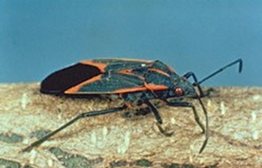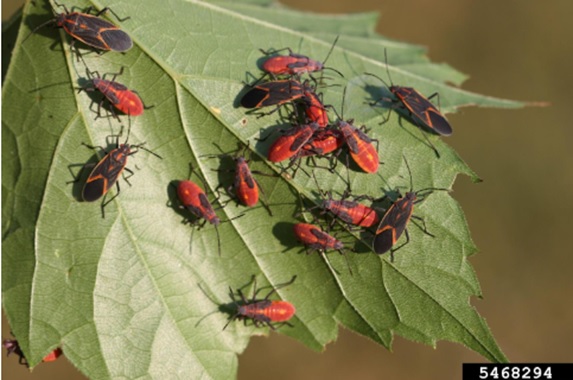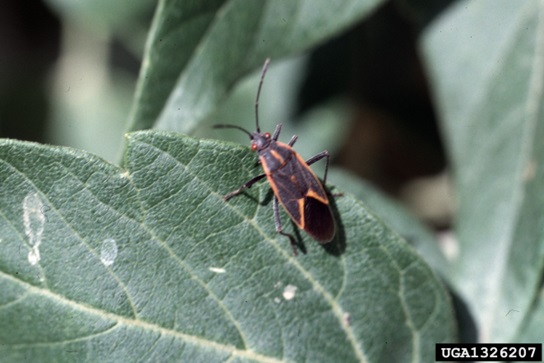Boxelder Bugs
ENTFACT-444: Boxelder Bugs | Download PDF
by Hannah Blevins, Graduate research assistant
Jonathan L. Larson and Zach DeVries, Extension specialists
University of Kentucky College of Agriculture
Fast Facts
- Boxelder bugs are true bugs that are commonly found on fruit-bearing boxelder, maple, and ash trees.
- While boxelder bugs can be an annoying presence during peak months, they do not bite or sting humans or animals. There is also no evidence that boxelder bugs can transmit diseases.
- Boxelders do not have the potential to become a serious indoor pest as they rely on fruit-producing trees to reproduce.
Introduction
Boxelder bugs (Boisea trivittata) represent a species of true bug that is present throughout much of the eastern United States1. As their name suggests, boxelder bugs are found most often on boxelder trees (Acer negundo), which act as their primary host. Boxelder bugs are reliant on the tree’s seeds as a food source, which is why they stick to female fruit-producing trees and are rarely found on male trees. While they are most often found on or around their namesake tree, boxelder bugs have also been reportedly seen on silver maples, sycamore maples, apple, pear, and plum trees2.

Boxelder bug females lay their eggs on the leaves and branches of these trees, where they will hatch in around 11 to 19 days4. While boxelder bugs spend most of their lives in their host trees, they will sometimes be found on the ground at the bottom of the tree eating the seeds from the fallen fruit, which makes up most of their diet5.
Identification
Boxelder bug adults have black bodies with red lines running down the center and sides of their pronotum, the plate covering the insect’s thorax. Nymphs appear bright red, and both nymphs and adults have dark red eyes. Adults can grow up to half an inch in length3.
One insect that the boxelder bug may be confused with is the milkweed bug (Oncopeltus fasciatus), which is also a plant-feeding hemipteran insect. Although boxelder bugs and milkweed bugs are roughly the same size and share the same colors, their patterns are different. While boxelder bugs are mostly black with thin red stripes, milkweed bugs have mostly orangish-red coloration separated by large patches or belt-like stripes of black.

Where Boxelder Bugs May Be Found
Boxelder bugs are commonly found near boxelder trees, whose range spans from New York to central Florida and as far west as Texas6, and this range is continuing to expand. Boxelder bugs begin to hatch in late May, and they will be active on host trees until early winter2. In order to warm themselves in the sun, boxelder bugs are often seen on the south side of trees, buildings, and other structures.
During the colder months, boxelder bugs typically overwinter in leaf litter. However, occasionally boxelder bugs have been found clinging to siding of buildings for shelter from the cold. There have also been occasional reports of boxelder bugs finding their way into homes or businesses during the colder months, mistaking indoor heating for springtime conditions.
Relationship with Humans
Boxelder bugs have not been reported to cause harm to humans, pets, or livestock in any way. They also are unlikely to transmit any sort of disease to humans, animals, or plants. Boxelder bugs have a high preference for boxelder trees, so they are not considered an important pest for agricultural systems.
If boxelder bugs do find their way into a home during the winter, they may be an annoying presence. While they do not bite or sting, boxelder bug fecal matter may stain fabrics or surfaces in the home. Similar to stinkbugs, they also release an unpleasant pungent odor when crushed. However, since females do rely on boxelder trees to lay their eggs, boxelder bugs do not have the potential to form a long-term infestation indoors.
Management
As boxelder bugs do not pose a significant risk to humans, animals, or agriculture, it is typically sufficient to not treat for them at all outdoors, as their populations will retreat again once the weather cools down. If boxelder bugs become an ongoing annoyance on or inside buildings, cutting down boxelder trees near the home or other structure may provide a solution. Chemical insecticides should not be applied directly to boxelder trees during flowering seasons as this could cause harm to beneficial insects, such as pollinators.

If boxelder bugs are found indoors during the fall or winter, they can be easily removed through sweeping or vacuuming. As boxelder bugs will not reproduce or live for long indoors, application of pesticides is usually not necessary. To prevent entry into the home during the cooler months, sealing any cracks around windows or doors may be sufficient to prevent boxelder bugs from getting inside.
Sources
1. Ciesla, W. M., & Hanavan, R. P. (2011). Forest Insect & Disease Leaflet 95- Boxelder Bugs. USDA Forest Service, (95).
2. Mallis, A. (2011). Chapter 18- Occasional Invaders and Overwintering Pests. In Handbook of Pest Control (10th ed., pp. 1227–1230). The Mallis Handbook Company.
3. Göllner-Scheiding, U. (1983): General-Katalog der Familie Rhopalidae (Heteroptera). Mitt. Zool. Mus. Berlin 59, 37–189.
4. Smith, RC and BL Shepherd 1937. The life history and control of the boxelder bug in Kansas. Trans. Kansas Acad. Sci. 40:143-159.
5. Tinker, M. E. (1952). The seasonal behavior and ecology of the boxelder bug Leptocoris Trivittatus in Minnesota. Ecology, 33(3), 407–414. https://doi.org/10.2307/1932836
6. Overton, R. P. (n.d.). Boxelder. USDA-Boxelder-Southern Research Station.
Issued: 10/00
Revised: 3/24
CAUTION! Pesticide recommendations in this publication are registered for use in Kentucky, USA ONLY! The use of some products may not be legal in your state or country. Please check with your local county agent or regulatory official before using any pesticide mentioned in this publication.
Of course, ALWAYS READ AND FOLLOW LABEL DIRECTIONS FOR SAFE USE OF ANY PESTICIDE!
